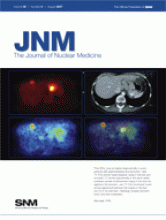TO THE EDITOR: We read with interest the article by Biehl et al. illustrating the current uncertainty surrounding the use of 18F-FDG PET to delineate the gross tumor volume (GTV) of non–small cell lung cancer (NSCLC) (1). The importance of this delineation is emphasized by the finding of Bradley et al. that GTV is of critical prognostic importance in NSCLC (2). CT is the current standard for NSCLC GTV delineation, but despite excellent spatial resolution, substantial interobserver variation exists (3). Several authors have described the use of 18F-FDG PET to refine the CT GTV, reporting both an increase and a decrease in the absolute GTV and improved interobserver agreement (4). Robust clinical data on the appropriateness of these changes are currently lacking. Although able to show the general locus of metabolic activity, the spatial resolution of most clinical PET systems is low, image quality is limited, the location of the tumor edge is unknown, and it is not clear how images should be viewed to best reflect actual geometry. Indeed, on this basis alone it would be surprising if adding 18F-FDG PET to CT did not result in changes to GTV. Better GTV consistency could in part reflect the 18F-FDG PET image presentation, in which the target is often bright and the colors contrasting (perhaps refining CT graphics could reduce interobserver variability?). 18F-FDG PET is also more forgiving of the operator's limited ability to distinguish normal from abnormal anatomy. As the authors indicate, tumor 18F-FDG uptake can be heterogeneous, and measured uptake intensity and apparent tumor volume may be affected by motion. A priori, it is therefore unlikely that a universal segmentation threshold would match nongated 18F-FDG PET and non–breath-hold CT GTVs in tumors of differing shapes and sizes. The findings of Biehl et al. highlight the difficulty in defining a universal threshold as suggested by phantom studies (5).
The authors highlight limitations in using 18F-FDG PET to delineate GTV. Some limitations are technical. For others, we suggest that 18F-FDG PET–pathology correlation could be useful and build on existing data (6). Such studies could help characterize tumor boundaries, assist image segmentation, and aid understanding of motion and apparent tumor volume. A current study (of which one of us is Principal Investigator), supported by the Ontario Cancer Research Network, aims to investigate concordance between NSCLC 18F-FDG PET and CT tumor imaging and postresection whole-mount tumor/lung pathology (7). Capitalizing on digital whole-mount histopathologic methods developed by a collaborator (8), the aim is to generate 3-dimensional pathologic reconstructions and then coregister and compare these with 18F-FDG PET/CT volumes. Although significant early challenges have been encountered in working with lung tissue, such studies are in their infancy. Daisne et al. have addressed similar questions in head and neck cancer, finding the 18F-FDG PET GTV more reflective of pathology than MRI or CT (9). They imaged patients in an immobilization mask, and there would have been little GTV motion, unlike in NSCLC (especially without breathing control or gating). Radiology–pathology correlation appears increasingly relevant to the paradigm of image-guided cancer therapy.
The paper of Biehl et al. is important because it illustrates the current complexity of integrating 18F-FDG PET and CT (without gating or breathing control) into NSCLC GTV delineation and, in so doing, sounds a cautionary note. Cognizant of the paucity of outcome data, the Ontario Clinical Oncology Group is performing a randomized clinical trial to assess the utility of 18F-FDG PET in staging locally advanced NSCLC (10) and has incorporated a prospective substudy (of which one of us is Study Chair) to evaluate the impact of 18F-FDG PET–refined GTV delineation. A caveat to the findings might be, however, that as technology changes, so too may its possible applications.
Footnotes
-
COPYRIGHT © 2007 by the Society of Nuclear Medicine, Inc.







